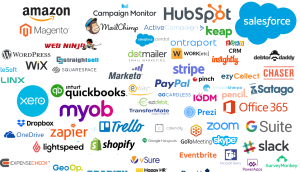
I wanted to call this post ‘The science of persuasion: How to create websites that convert visitors into customers without resorting to sleazy or manipulative sales tactics’… but that was really too long!
Marketing is arguably the biggest block from a small business taking off. You can really know your craft/product, but if you don’t have any marketing skills you will really struggle – especially in the fiercely competitive online marketplace!
Below I’ll run through the basics, how to use the science of persuasion to *gently* nudge website visitors to convert into paying customers. No sleazy manipulation, no discounting your products just to make a sale.
Getting started: How do you create websites that convert?
Before we dive into creating websites that convert, it’s crucial to understand the psychology behind persuasion. Humans are wired to respond to certain triggers and cues that influence their decision-making process. By tapping into these psychological principles, you can create a website that resonates with your visitors on a deeper level.
One key principle of persuasion is the concept of social proof. People tend to look to others for guidance when making decisions. By showcasing testimonials, reviews, or social media followers, you can establish credibility and build trust with your visitors. Another important psychological trigger is scarcity. When something is perceived as limited or exclusive, it becomes more desirable. Incorporating scarcity tactics, such as limited-time offers or limited stock notifications, can create a sense of urgency and drive visitors to take action.
In addition to social proof and scarcity, understanding the power of emotions is crucial in persuasion. Emotionally charged content engages visitors and makes your message more memorable. By tapping into the desires, fears, or aspirations of your target audience, you can create a strong emotional connection that drives them to convert.
Key principles of persuasive website design that converts
The layout, color scheme, and overall aesthetic of your website can significantly impact how visitors perceive your brand and whether they are compelled to take action.
First and foremost, your website should have a clear and intuitive navigation structure. Visitors should be able to easily find what they are looking for without feeling overwhelmed. A cluttered or confusing website will only lead to frustration and high bounce rates. *ahem, we can help with this!*
Another important principle is the use of visual hierarchy. By strategically placing elements on your website, you can guide visitors’ attention and highlight important information. For example, using larger fonts, bold colors, or contrasting backgrounds can draw attention to your call-to-action buttons or key selling points.
Furthermore, the color scheme of your website plays a vital role in persuasion. Different colors evoke different emotions and can influence visitors’ perceptions of your brand. For example, blue is often associated with trust and reliability, while red can create a sense of urgency or excitement. By carefully selecting your color palette, you can create a website that aligns with your brand personality and resonates with your target audience.
Using persuasive copywriting
One effective technique in persuasive copywriting is the use of storytelling. By weaving narratives into your content, you can engage visitors on an emotional level and make your message more relatable. Sharing success stories or customer testimonials can also provide social proof and build trust.
Also, using persuasive language and power words can evoke strong emotions and create a sense of urgency. Words such as “exclusive,” “limited,” or “guaranteed” can make your offers more enticing. Additionally, using action-oriented verbs in your call-to-action buttons, such as “get started” or “unlock now,” can encourage visitors to take immediate action.
persuasive call to action buttons
One of the most critical elements of websites that convert is the call-to-action (CTA) button. A well-designed CTA button can make all the difference in converting visitors into customers.
Firstly, your CTA button should stand out from the rest of your website. It should be visually distinct and easily recognizable. Using contrasting colors or bold typography can help draw attention to your CTA button and make it more clickable.
Also, the language used in your CTA button should be clear, concise, and action-oriented. Instead of using generic phrases like “submit” or “click here,” try using more compelling and specific language. For example, “Start your free trial” or “Get instant access” clearly communicate the value of taking action and entice visitors to click.
Additionally, the placement of your CTA button is crucial. It should be strategically positioned where visitors’ attention naturally gravitates. Placing your CTA button above the fold, meaning it is visible without scrolling, can increase its visibility and effectiveness.
Leverage social proof
Social proof is a powerful persuasion tool that can significantly impact visitors’ decision-making process. People tend to trust the opinions and experiences of others, especially when making purchasing decisions. By leveraging social proof and showcasing testimonials, reviews, or case studies, you can build credibility and instill confidence in your visitors.
When incorporating social proof into your website, it’s important to use authentic and relevant testimonials. Including specific details, such as the customer’s name, photo, or company, can make the testimonials more credible. Additionally, featuring testimonials from well-known or influential individuals in your industry can further enhance your brand’s credibility.
Another effective way to leverage social proof is by displaying the number of customers or subscribers you have. For example, “Join over 10,000 satisfied customers” or “Trusted by industry leaders” can create a sense of popularity and trustworthiness.
Incorporating scarcity & urgency
Scarcity and urgency tactics can create a sense of FOMO (fear of missing out) and push visitors to take immediate action. By emphasizing limited-time offers, limited stock availability, or countdown timers, you can create a sense of urgency and drive visitors to convert.
One effective tactic is the use of countdown timers. Adding a timer to your limited-time offers or flash sales can create a sense of urgency and make visitors feel like they need to act quickly to secure the deal. Additionally, highlighting limited stock availability, such as “Only 3 left in stock” or “Limited edition,” can create a fear of missing out and drive visitors to make a purchase.
However, it’s important to use scarcity and urgency tactics ethically and transparently. Creating false scarcity or misleading visitors can damage your brand’s reputation and trustworthiness. Be genuine and honest in your approach, and ensure that the scarcity or urgency is legitimate.
Optimise your website to load fast
In today’s fast-paced digital world, visitors have little patience for slow-loading websites. A slow website not only frustrates users but also negatively impacts your conversion rates. Therefore, optimizing your website’s loading speed is crucial for creating a positive user experience and improving conversion rates.
There are several ways to optimize your website’s loading speed. First, ensure that your images are properly compressed and optimized for the web. Large image files can significantly slow down your website. Additionally, minifying your CSS and JavaScript files, leveraging browser caching, and using a content delivery network (CDN) can all help improve your website’s loading speed.
Try A/B testing
To continuously improve your website’s conversion rates, it’s essential to conduct A/B testing. A/B testing involves comparing two versions of a webpage to determine which one performs better in terms of conversion.
When conducting A/B tests, it’s important to test one element at a time to accurately measure its impact. For example, you could test different variations of your CTA button, headline, or color scheme. By measuring the conversion rates of each variation, you can identify the most effective elements and optimize your website accordingly.
A/B testing is an ongoing process that should be carried out regularly to ensure continuous improvement. By systematically testing and optimizing different elements of your website, you can create a website that is constantly evolving and maximizing its conversion potential.
Apply persuasive website design that converts to your own website!
In conclusion, creating websites that convert your visitors into customers requires a deep understanding of the science of persuasion. By combining psychological principles with strategic design and compelling copywriting, you can create a persuasive website that captivates your visitors and convinces them to take action.
From understanding the psychology of persuasion to leveraging social proof, scarcity, and urgency tactics, each element plays a crucial role in the conversion process. Optimizing your website’s loading speed, conducting A/B testing, and studying successful case studies can further enhance your website’s conversion potential.
Remember, creating a persuasive website is an ongoing process. Continuously monitor and analyze your website’s performance, and be willing to adapt and optimize based on the data. By applying the science of persuasion to your website, you can unlock the secrets to turning your visitors into loyal customers.
So, what are you waiting for? Dive into the world of persuasion and start transforming your website into a conversion powerhouse!





